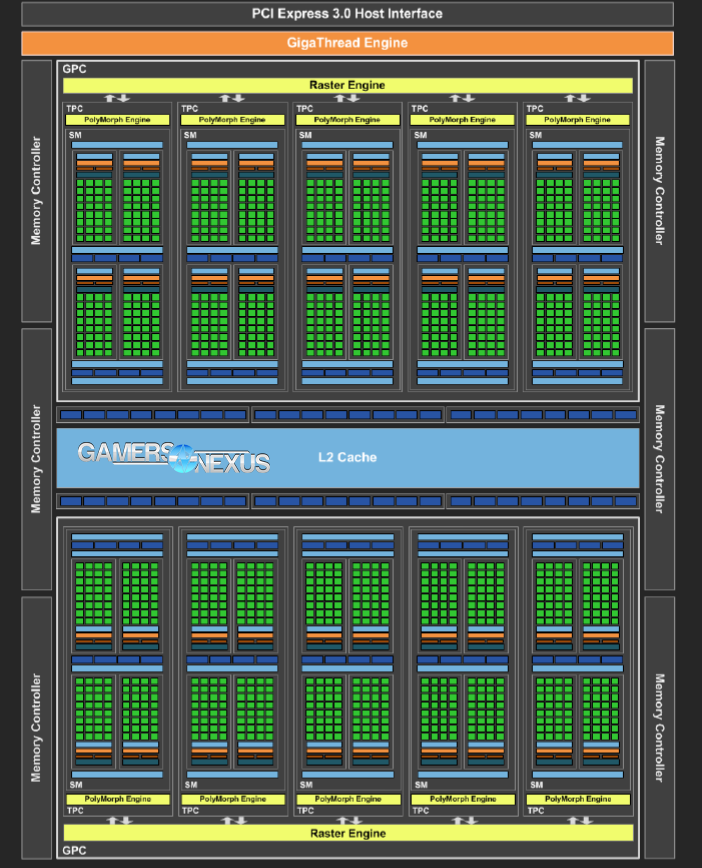There were rumors of a GTX 1060 3GB card, but the launch of the GTX 1060 featured a single 6GB model. Almost exactly one month later, nVidia has announced its 3GB GTX 1060 with 1152 CUDA Cores, down from 1280, and a halved framebuffer. The card will also run fewer TMUs as a result of disabling 1 SM, for a total of 9 simultaneous multiprocessors versus the 10 SMs on the GTX 1060 6GB. This brings down TMU count from 80 to 72 (with 8x texture map units per SM), making for marginally reduced power coupled with a greatly reduced framebuffer.
(Update: The card is already available on etailers, see here.)
In theory, this will most heavily impact 0.1% low and 1% low frame performance, as we showed in the AMD RX 480 8GB vs. 4GB comparison. Games which rely less upon Post FX and more heavily upon large resolution textures and maps (as in shadow, normal, specular – not as in levels) will most immediately show the difference. Assassin's Creed, Black Ops III (in some use cases), and Mirror's Edge Catalyst are poised to show the greatest differences between the two. NVidia has advertised an approximate 5% performance difference when looking at the GTX 1060 3GB vs. GTX 1060 6GB, but that number will almost certainly be blown out when looking at VRAM stressing titles.
NVIDIA GeForce GTX 1060 6GB vs. 3GB Specs
| NVIDIA Pascal vs. Maxwell Specs Comparison | |||||
| GTX 1080 | GTX 1070 | GTX 1060 3GB | GTX 1060 6GB | GTX 960 | |
| GPU | GP104-400 Pascal | GP104-200 Pascal | GP106 Pascal | GP106 Pascal | GM204 |
| Transistor Count | 7.2B | 7.2B | 4.4B | 4.4B | 2.94B |
| Fab Process | 16nm FinFET | 16nm FinFET | 16nm FinFET | 16nm FinFET | 28nm |
| CUDA Cores | 2560 | 1920 | 1152 | 1280 | 1024 |
| GPCs | 4 | 3 | 2 | 2 | 2 |
| SMs | 20 | 15 | 9 | 10 | 8 |
| TPCs | 20 | 15 | 9 | 10 | - |
| TMUs | 160 | 120 | 72 | 80 | 64 |
| ROPs | 64 | 64 | 48 (?) | 48 | 32 |
| Core Clock | 1607MHz | 1506MHz | 1506MHz | 1506MHz | 1126MHz |
| Boost Clock | 1733MHz | 1683MHz | 1708MHz | 1708MHz | 1178MHz |
| FP32 TFLOPs | 9TFLOPs | 6.5TFLOPs | 3.85TFLOPs | 3.85TFLOPs | 2.4TFLOPs |
| Memory Type | GDDR5X | GDDR5 | GDDR5 | GDDR5 | GDDR5 |
| Memory Capacity | 8GB | 8GB | 3GB | 6GB | 2GB, 4GB |
| Memory Clock | 10Gbps GDDR5X | 4006MHz | 8Gbps | 8Gbps | 7Gbps |
| Memory Interface | 256-bit | 256-bit | 192-bit | 192-bit | 128-bit |
| Memory Bandwidth | 320.32GB/s | 256GB/s | 192GB/s | 192GB/s | 115GB/s |
| TDP | 180W | 150W | 120W | 120W | 120W |
| Power Connectors | 1x 8-pin | 1x 8-pin | 1x 6-pin | 1x 6-pin | 1x 6-pin |
| Release Date | 5/27/2016 | 6/10/2016 | August, 2016 | 7/19/2016 | 01/22/15 |
| Release Price | Reference: $700 MSRP: $600 | Reference: $450 MSRP: $380 | MSRP: $200 | Reference: $300 MSRP: $250 | $200 |
In other marketing language, nVidia directly claims a 10% speed increase in the 3GB GTX 1060 over the 8GB RX 480. Again, that'll depend on the game and can't just be applied as a blanket performance swing, so we'll validate that ourselves.
Above: Ignore one SM. That's the 3GB model.
Availability of the GTX 1060 3GB card will begin “over the next couple of weeks,” with a driver update pushed today to support the card. NVidia does not plan to seed the cards directly for review, but that won't stop us from running 3GB vs. 6GB comparisons and validating the percentage performance claims. The clock-rate is actually the same on both models, and the same goes for the memory clock -- so performance should be mostly identical, sans the core difference and games with real memory dependencies.
The card will be priced at $200, landing it about $50 cheaper than the low-end of the GTX 1060 MSRP, and equal with the 4GB RX 480. We have not received word if this will have a reference card.
- Steve “Lelldorianx” Burke.
